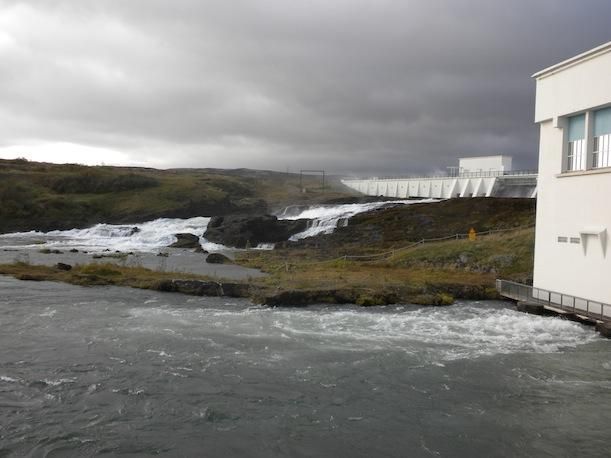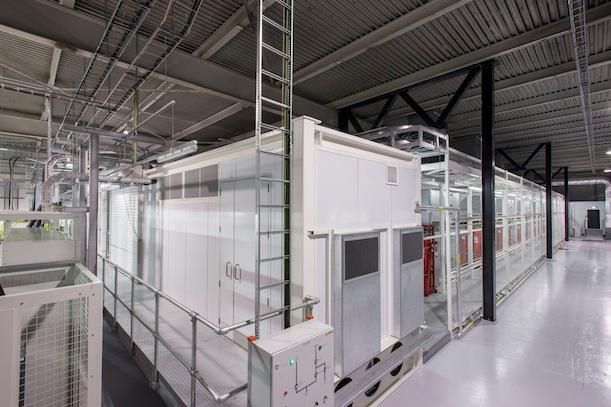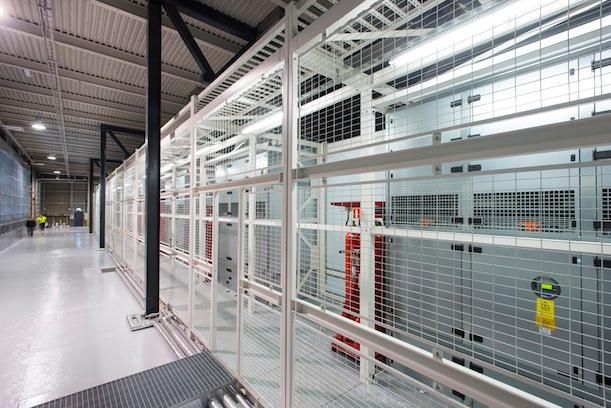Is the Future of the Internet in Iceland?
With free air cooling and 100 percent renewable electricity, does it make sense to outsource our data to Iceland?
/https://tf-cmsv2-smithsonianmag-media.s3.amazonaws.com/filer/8b/8f/8b8f339f-3e5e-40ec-8232-b3d8bea51554/server-cabinets.jpg)
When you clicked on the link to read this article, your computer, tablet or phone sent a request that traveled hundreds or perhaps thousands of miles at the speed of light. After leaving your house or office, likely via a fiber optic cable, it traversed the continent, crossing through a handful of Internet exchanges along the way. Ultimately, it reached a data center in Chicago where Smithsonian.com stores its data—the “cloud,” of course, isn't really a cloud—and triggered a packet of data to be sent back in the opposite direction, bringing the text, images, and links in this article to your screen.
Soon, though, the packers of data your computer requests when you browse the web might make a slight detour as part of its journey to a data center and back to your house. Much like how, when you call for tech support, you're likely to speak to someone in India, we might be on the verge of an age where we routinely outsource much of our data to the frigid island of Iceland.
"There is no reason why Iceland shouldn't have a major market share in international data hosting in the next ten years," Isaac Kato, a CFO at Verne Global—the company that’s currently expanding their year-old data center near the capital of Reykjavik—told me last month when the company brought me to Iceland to see their new facilities. As he courts customers, his company’s selling point is simple: Iceland is a perfect mix of fire (as in geothermal energy) water (hydropower) and ice (cold air, to cool racks of servers without AC). In the data storage industry where the biggest cost is electricity, Verne Global claims they can provide enough cheap, 100 percent carbon-neutral power to make the trip more than worthwhile.
Their idea isn't entirely new—Facebook is building data centers in northern Sweden, near the Arctic Circle, to similarly take advantage of natural air conditioning, and the company Advania operates a smaller data center in Iceland as well. But Verne could be a harbinger of a much bigger trend: Hosting the data of international companies that have nothing to do with Iceland, thousands of miles away from their operation.
What make all this possible are the undersea fiber optic cable lines that connect Iceland to Europe and North America. Because fiber optic data travels at the speed of light, a trip from New York to Iceland and back takes about 80 milliseconds. But plenty of countries are wired with fiber optics. Given the immense power consumption of data centers—Google’s suite of data centers, spread all around the world use enough electricity to power a city of 750,000 people—Iceland's uniquely attractive attribute is the fact that it is literally overflowing with carbon-free energy.

Iceland built its first hydroelectric plant in 1937 as part of an effort to supply many of Reykjavik’s houses with electricity for the first time. One of the first places I visited upon arriving to the country was Irafross hydropower plant on the River Sog, built a few miles downstream from the first plant in 1953 and now one of 13 hydropower stations operated by the state-owned power company Landsvirkjun. Given that Iceland is trying to brand itself as a waypoint for the digital information that keeps the world connected, it felt ironic that the 45-minute drive to the power plant from Reykjavik was strikingly sparse and remote. Craggy, windswept lava flows run underneath high-voltage transmission lines, and grazing sheep dot the landscape.
After entering the building, we donned hardhats and descended a four-story concrete spiral staircase, walking past whirling turbines and through a moss-covered access tunnel. “Be careful to watch your head,” said Rikardur Rikadsson, a genial company representative, shouting over the gushing of nearly 40,000 gallons of water per second, discharged back into the river after spinning a series of turbines that can produce up to 48 megawatts of electricity at any given time. In the scheme power plants as a whole, this output, which can power somewhere on the order of 15,000 homes, is a fairly small number; a typical coal plant can produce 600 megawatts of electricity.
In the U.S. and most other countries, renewable electricity is a boutique industry. In Iceland, it’s the only game in town. Currently, 26 percent of the country’s electricity comes from geothermal energy and 74 percent comes from hydropower. When you plug your television into a wall outlet in Iceland, the juice coming out is entirely carbon-neutral.
But for a sparsely populated country of about 320,000 (a bit larger than the population of Corpus Christi, Texas), this is actually too much power. The nation produces almost twice as much electricity per capita as any other country and is actively trying to figure out what to do with it. Sources of renewable energy, unfortunately, can’t be shipped in barges like coal. Plants can’t send waterfalls or geothermal heat across an ocean. Plans to build an electricity transmission line to Europe are occasionally discussed, but it’s estimated that producers would lose 7 percent of the electricity during transmission and the necessary infrastructure would be excessively expensive.
“For years, the power companies here thought, ‘How do we get the power from Iceland to Europe?’” says Jeff Monroe, Verne’s CEO. “We believe we’ve found the most efficient way to do that. We’re shipping power out of Iceland and around the world in the form of bits and bytes over fiber optic cables.”
* * *

“For all the breathless talk of the supreme placelessness of our new digital age, when you pull back the curtain, the networks of the Internet are as fixed in real, physical places as any railroad or telephone system ever was,” writes Andrew Blum in his book Tubes: A Journey to the Center of the Internet. Verne’s new data center, built on a decommissioned NATO base outside of Reykjavik, is one of these real, physical places.
The company was founded in 2007 by Isaac Kato and others who hoped to capitalize on the world’s rapidly growing data streams and Iceland’s unique energy situation. But shortly after they announced their plans, they were abruptly halted. “I came on board in September 2008—a week or so before the crash,” says Monroe, referring to the crippling financial crisis that caused the country’s GDP to fall by 5.5 percent in a six-month span. “No matter what you were doing in Iceland, you were impacted.” By the end of 2009, though, when the undersea fiber optic links to Europe and North America were completed, the situation had improved, and Verne decided to press forward. In 2011, the company purchased an existing warehouse from NATO, repurposed it with their own infrastructure and opened for business, though it is still expanding and filling the space with more servers and machines.
Given how open, in many ways, our new digital age seems to be, there’s something surprising about the back-end places where our bits originate; they’re intensely secretive. I wasn’t allowed to take pictures inside the area of the data center with the actual server racks, and getting our tour group into the facility necessitated an elaborate security procedure that involved fingerprint-activated locks.
Once inside the aluminium-walled warehouse, we strolled through a frigid industrial hall filled with enormous machines. This was what one of the center’s “cold aisles,” filled with the devices that ensure the servers stay powered, cooled to the right temperature and kept at the correct humidity at all times. “I want to remind everyone that this is an active facility, so hands in pockets at all times,” Tate Cantrell, Verne’s technology officer and our tour guide, told us. At the end of the building, a freezing draft blew in through a two story-tall wall made up mostly of air filters. “The wind outside? That’s our free air-cooling,” he said. On average, half of a conventional data center’s energy goes toward cooling down the servers as they heat up, the same way your laptop’s fan starts whirring when you run a bunch of programs at once. Instead, at this facility, they simply piped in the wind and funneled it towards the backs of the machines.
Even so, when we entered the locked aisle that gave access to the front of the servers, the temperature felt like it immediately jumped up 20 degrees or so. Crunching data generates a ton of heat. Cantrell provided cryptic, jargon-filled descriptions of the hardware, but the sci-fi-styled server cage, I was told, looked more or less like all data centers: racks upon racks of servers strung with snaking cables, silently running lines of code and served bytes of data to users far, far away.
It’s impossible to say exactly what their purpose was at that very moment—a few companies (BMW and RMS, a catastrophic risk modeling company) have publicly announced their use of the Verne facility, but most are reluctant to for security reasons. But the basic idea is this: Of a company’s digital activities, there are some that need to be close to a geographical center—financial trading software, for instance, needs to be able to capitalize on the split-second response times that putting infrastructure in Manhattan allows—but for the vast majority, an extra 80 milliseconds of lag time won’t make a big difference. Companies that want to take advantage of this can either rent space in Verne’s server racks for their own hardware or buy computing capability as they need it.

Given all the benefits Verne claims to offer, why aren’t thousands of companies moving their data to Iceland right now? One reason is the perception of Iceland as a volatile place to do business. Apart from the financial crisis—from which the country finally seems to be recovering—there are natural disasters. The island itself is a volcano, formed by the continual spreading of the Mid-Atlantic ridge, and a 2010 eruption spewed ash that shut down air travel throughout Europe for an entire week. Associated earthquake activity, though rare, is also a concern. Due to the use of natural air cooling, some worry that volcanic ash could infiltrate the center and interrupt operations, while earthquakes could damage infrastructure.
But Verne officials say these concerns are overblown. “No matter where you put a data center, there’s risk,” said Monroe, the CEO. “Northern New Jersey, for instance—there are a ton of data centers there, and we saw during Sandy how risky that was.” Gawker.com, for instance, was knocked offline during the storm due to power failures at its New York-area facility. To minimize their risk, Verne put its facility on the former NATO base, which sits on secure bedrock, far away from the island’s seismic activity and upwind from the volcanic activity, and have measures in place to shut down the outdoor air intake in the event of an eruption.
But for some customers, there may be one problem that persists no matter how many precautions Verne takes: latency. 80 milliseconds—the length of time it takes a piece of data to fly from New York to Iceland and back, under ideal conditions—might not sound like much, but for some companies, it might be a deal breaker. In the past, Google has found that merely increasing the time a search takes from 400 to 900 milliseconds causes a 20 per cent drop in traffic. Given the unavoidable delays already present (computing time, the time it takes for data to cross the continental U.S., etc.), tacking on an extra 80 milliseconds could be undesirable. And while Google might be able to build multiple data centers—those in remote, inexpensive places with abundant energy, like Iceland, and those near users specifically built for time-sensitive tasks—smaller companies might not have this luxury, and are forced to put all their eggs in one basket, says James Hamilton, an engineer with Amazon Web Services.

For larger companies with flexibility, it may be that getting used to the idea of outsourcing data is the biggest hurdle to overcome—the same way outsourcing call centers was a strange idea, until it became normal. “It’s hard to go be the first person to move your data there,” says Rich Miller, the editor-in-chief of Data Center Knowledge. “No one wants to take a risk and have it backfire.”
But it seems that Verne might indeed be at the forefront of a trend. In addition to leasing space in Verne’s facility, BMW has discussed building their own data center nearby, in anticipation of all the data that’ll be used by their increasingly connected cars, equipped with their new ConnectedDrive technology, which provides drivers with cloud-based voice control and real-time traffic information over a wireless connection.
Given the negative publicity companies like Facebook and Apple have received from Greenpeace campaigns protesting their heavy dependence on coal power, the eventual possibility of carbon emission regulations and the resulting increases in energy costs, and the fact that Icelandic utilities offer 20-year fixed-price contracts on carbon-neutral energy for industrial users like power centers, figuring out a way to power data with clean energy in the long term makes a lot of sense. Right now, the data running through your computer or tablet probably didn’t come from Iceland, but wait a year, five years, or a decade. Eventually, there’s a good chance that the cloud will have relocated to a frigid island nation across the Atlantic.
/https://tf-cmsv2-smithsonianmag-media.s3.amazonaws.com/accounts/headshot/joseph-stromberg-240.jpg)
/https://tf-cmsv2-smithsonianmag-media.s3.amazonaws.com/accounts/headshot/joseph-stromberg-240.jpg)